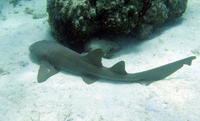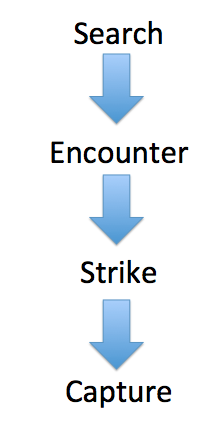FishPredation
From coraldigest
Fish Predation
Common Methods
- Stalking
- Chasing
- Ambush
- Habituation
- Angling
Predation Model
- Energy vs. Cost
- Factors Affecting Search:
- For Predator: Hunger
- For Prey: Camouflage
- Factors Affecting Encounter
- For Predator: Swimming Speed, water clarity, illumination, schooling, detection mechanisms
- For Prey: morphology, activity level, pigmentation, distribution
- Factors Affecting Strike
- For Predator: alternative prey, location
- For Prey: body size, sensory ability
- Factors Affecting Capture
- For Predator: mouth gape, strike speed, handling
- For Prey: escape capabilities, schooling, shelter seeking behavior[1]
This diagram shows the factors that affect juvenile feeding behavior.
[2]
Other Feeding Factors
- Size is the most important factor in determining predation rates
- ex: There is a decreasing rate of predation with Jellyfish as fish larvae size increases.
- Predation happens at all sizes
- Ex: microscopic organisms to large whales
- Highest rates of predation occur on juvenile fish.
- Predation is most common during life transitions.
- Ex: after fish larvae hatch[3]
- Most are active either during the day or at night, not 24 hours
- Diurnal or nocturnal feeding is normally fixed genetically[4]
Importance of Predation
- Food web
- trophic cascade/ top-down control

- Important Evolutionary Force
Predation is a strong force of natural selection. The weaker species is eliminated. Fish Predation is an important evolutionary force because when certain types of fish are targeted by predators they do not have as great of a survival rate. They are either forced to acclimate and as numbers dwindle and the more advantageous fish win out, and the fish population will evolve over time. [1] [1]
References
- ↑ 1.0 1.1 1.2 1.3 K.M. Bailey, JT. Duffy Anderson. 2001. Fish Predation and Mortality. Encyclopedia of Ocean Sciences (Second Edition). Pages 417-421.
- ↑ A. D. Nunn, L. H. Tewson, and I. G. Cowx. The foraging ecology of larval and juvenile fishes. Hull International Fisheries Institute, Department of Biological Sciences, University of Hull, Hull, HU6 7RX, UK. Published online: 26 October 2011
- ↑ Hixon, Mark A. 1991. Predation as a Process Structuring Coral Reef Communities.Oregon State University Publishing. http://hixon.science.oregonstate.edu/files/hixon/publications/026%20-%20Hixon%2091%20Sale%20book.pdf
- ↑ Houlihan, Dominic. 2001. Food Intake in Fish. Blackwell Science. Pages 189-209.
